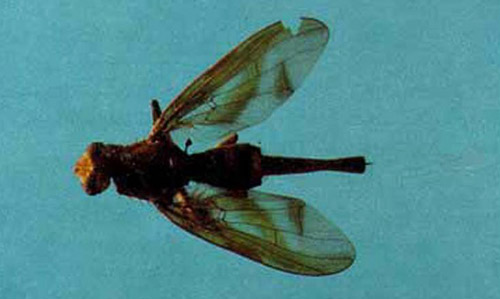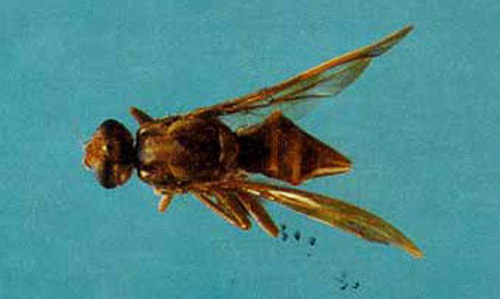common name: South American cucurbit fruit fly
scientific name: Anastrepha grandis (Macquart) (Insecta: Diptera: Tephritidae)
Introduction - Synonymy - Distribution - Identification - Hosts - Survey and Detection - Selected References
Introduction (Back to Top)
The South American cucurbit fruit fly, Anastrepha grandis (Macquart), which exists in several South American countries, attacks watermelon and other fruits of the family Cucurbitaceae. Once a pest of minor to moderate importance generally, it has become a rather important pest. The pest status differs in each country and has sometimes changed within a country . This species is potentially of economic importance in Florida and southern Texas should it ever be introduced there. It has been intercepted in the United States in pumpkin from Argentina and Brazil, and in banana debris from Panama.
Synonymy (Back to Top)
Acrotoxa grandis (Macquart)
Anastrepha schineri Hendel
Anastrepha latifasciata Hering
Tephritis grandis Macquart
Trypeta grandis (Macquart)
Distribution (Back to Top)
This species is established in South America: Argentina, Bolivia, Brazil (except north), Colombia, Ecuador, Panama, Paraguay, Peru and Venezuela (NAPPO 2009).
Identification (Back to Top)
Rather large, yellow-brown, with yellow and dark-brown markings. Mesonotum is 3.3–4.0 mm long, yellow-brown, with humerus, median stripe widening to include acrostichal bristles but not reaching scutellum, lateral stripes from just before transverse suture to side of scutellum, stripe below notopleuron, metapleuron, and scutellum except extreme base yellow; a sublateral stripe from level of humeral bristle to scutellum, broken at transverse suture, a band along scutoscutellar suture, intensified medially, and a spot on pteropleuron dark brown; metanotum blackened laterally. Macrochaetae dark brown; pile yellowish brown. No sternopleural bristle. The wing is 9.0–10.5 mm long, the bands yellow brown, rather diffuse; costal and S bands broadly connected, and no distinct hyaline spot anterior to vein R4 + 5; distal arm of V band absent, the proximal arm not joining S band.
Figure 1. Adult female South American cucurbit fruit fly, Anastrepha grandis (Macquart). Photograph by Division of Plant Industry.
Figure 2. Adult male South American cucurbit fruit fly, Anastrepha grandis (Macquart). Photograph by Division of Plant Industry.
Female terminalia: The ovipositor sheath is 5.8–6.2 mm long, tapering posteriorly to apical third, which is distinctly depressed and broadened; in profile the sheath is distinctly concave dorsally on median half and concave ventrally on apical third. Rasper well developed, of slender, curved hooks in five or six rows. Ovipositor slightly longer than length of ovipositor sheath, being somewhat curved dorsoventrally to permit fitting into sheath; tip long and slender, without serrations; extreme base slightly widened (Stone 1942).

Figure 3. Rasters at tip of ovipositor sheath. Drawing by Division of Plant Industry.

Figure 4. Ovipositor. Drawing by Division of Plant Industry.
Steyskal (l977) distinguished adult A. grandis from the other four species of the Grandis group as follows:
1. Vein R3 somewhat undulant; metanotum yellow . . . . . A. bezzii Lima and A. balloui Stone
1'. Vein R3, not undulant; metanotum marked with black . . . . . 2
2. Mesonotum not striped with black . . . . . A. atrigona Hendel
2'. Mesoscutum with black stripes . . . . . 3
3. Mesoscutum and pleura largely black, wing with pattern darkened . . . . . A. shannoni Stone
3'. Mesoscutum and pleura with little black, wing pattern very little darkened . . . . . A. grandis (Macquart)
Hosts (Back to Top)
- Citrullus lanatus, watermelon
- Cucumis melo, "honeydew melon"
- Cucumis sativus, cucumber
- Cucurbita maxima, autumn and winter squash, pumpkin
- Cucurbita pepo, summer and autumn pumpkin and squash, gourd, marrow
- Cucurbota moschata, butternut squash and pumpkins
- Lagenaria siceraria, bottle gourd or calabash
It has also been known to attack common guava, Psidium guajava (Norrbom 2004). The record of rearing from oranges (Greene 1934) is erroneous. Immature fruits of cucurbits apparently are preferred, but mature or nearly mature fruits of some cucurbits are attacked occasionally.
Survey and Detection (Back to Top)
Adults are easily recognized by their relatively large size (wing length 10 mm), long aculeus (a sharp spine jutting from beneath the margin of the eight sternite) and rather diffuse wing markings which are not of the typical Anastepha type.
Larvae can be collected from infested fruit and are very difficult to identify to species except when reared to adults. For best larval preservation, kill in boiling water, place in 50% isopropyl alcohol for two days, then in 75% isopropyl alcohol. Adults may be collected on stickyboard and in baited traps.
Selected References (Back to Top)
- Enkerlin D, Laura-Garcia R, Fidel-Lopez M. 1989. pp. 83-90. In Robinson AS, Hooper G (editors), Fruit Flies, Their Biology, Natural Enemies and Control. 3A: I-xii, 1-372.
- Foote RH. 1967. Family Tephritidae. In Vanzolini, M. (editor), A Catalogue of the Diptera of the Americas South of the United States. 57: 1-91. Dept. Zool., Sec. Agric., São Paulo, Brazil.
- Greene CT. 1934. A revision of the genus Anastrepha based on a study of the wings and on the length of the ovipositor sheath (Diptera: Trypetidae). Proceedings of the Entomological Society of Washington 36: 127-179.
- Macquart J. 1846. Diptères exotiques nouveaux ou peu connus. (1845) (1844): 133-364, illus. Mém. Soc. Roy. Sci., Agric., Arts Lille. (published separately as Supplément I, p. 5-238.
- Norrbom AL. (2004). Host plant database for Anastrepha and Toxotrypana (Diptera: Tephritidae: Toxotrypanini). Diptera Data Dissemination Disk 2 (CD-ROM). North American Dipterist's Society. Washington, D.C.
- Steyskal GC. 1977. Pictorial Key to Species of the Genus Anastrepha (Diptera: Tephritidae). (Special publication) Entomological Society of Washington 35 pp.
- Stone A. 1942. The Fruitflies of the Genus Anastrepha. U.S. Department of Agriculture Miscellaneous Publication No. 439, Washington, DC. 112 pp.
- White IM, Elson-Harris MM. 1994. Fruit Flies of Economic Significance: Their Identification and Bionomics. CAB International. Oxon, UK. 601 pp.

